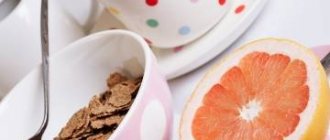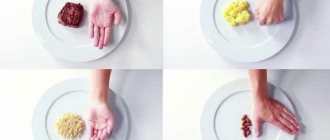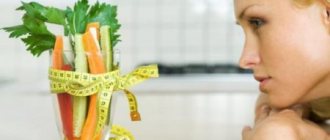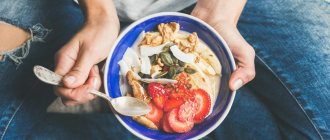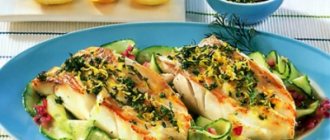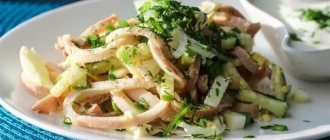Why you need to have lunch
Lunch is considered a full meal between 12 and 15 noon. It is designed to replenish the energy deficit that was wasted in the first half of the day and make a reserve of calories for the evening. By skipping lunch, we force the body to stock up on nutrition in the morning. All internal systems switch to “economy mode”, and all eaten food turns into fat deposits. That is why nutritionists do not recommend giving up a full meal even for people who are prone to being overweight.
Skipping lunch does not allow a person to control the evening meal, which should be much lower in calories than the daytime meal. Returning home hungry, it is difficult to refuse those dishes and delicacies that were so lacking during the lunch break. The result is overeating, heaviness in the stomach and accumulation of fats in “problem” areas.
But a healthy lunch is especially important for our health. Rational nutrition is the basis of good health and smooth functioning of all internal organs. A well-designed diet can supply the body with all the useful substances, but at the same time does not allow you to overeat and feel heaviness in the stomach.
What else is the benefit of lunch:
- distracts from everyday worries;
- allows you to take a break from work duties;
- improves mood;
- relieves the painful feeling of hunger and unpleasant rumbling in the stomach;
- eliminates headaches and improves overall well-being;
- serves as a prevention of diseases of the digestive tract;
- helps avoid depression and chronic stress;
- improves night sleep;
- normalizes weight and helps avoid obesity.
Important! Nutritionists recommend taking at least 30 minutes for lunch and eating not at your workplace, but in a specially designated dining area.
⚙ Lunch portion size
A proper lunch allows you to be full, but not overeat. Before eating, the capacity of an adult's stomach is approximately 450-500 ml. Of course, if necessary, it can stretch up to three liters, and for some “gourmets” even up to a record four. But why force yourself like that? To get a moment of pleasure, and then suffer for hours? That is why the volume of one serving should be small, approximately the same as what can fit in folded palms. This applies only to the main dish, but not to light leaf salads. They contain a lot of carbohydrates, which will take time for the body to absorb. This means that the feeling of hunger will not return soon. If you also take into account the low calorie content of salads, you can safely eat a large portion.
What should a proper lunch be like?
Daily food intake reflects not only dietary habits, but also a person’s lifestyle. This is why it is so difficult to change your usual routine and adapt it to a healthy diet. It is especially difficult for people who are forced to work on a tight schedule, when there is sorely not enough time to have a leisurely lunch.
In fact, organizing a rational lunch is not difficult - just follow simple rules:
- have lunch at the same time so that the stomach adjusts to the regime and begins to produce juice by the designated date;
- To prevent the feeling of hunger at lunch from being “brutal”, you should not skip breakfast, and the morning meal should be energetic;
- It is best if the lunch break occurs 4 hours after breakfast;
- Each piece of food should be chewed very slowly, this will allow you to get full faster and facilitate the functioning of the digestive system;
- you need to correctly calculate the serving size - the food should saturate, but not overload the stomach;
- 1-2 hours before lunch you can make a light fruit snack - eat an apple, grapefruit, pear or peach;
- The same snack can be made an hour after lunch.
The most important rule of a healthy lunch is that eating should be enjoyable. Tasteless and boring-looking food will not benefit your physical or mental health. If you don’t feel like eating a dish at all, you shouldn’t force yourself - perhaps this is the body’s way of telling you that such food will not be healthy.
You need to learn one more fact - the feeling of fullness comes not during lunch, but after it. It is better to get up from the table with a slight feeling of hunger - after just 10-15 minutes you will feel full without an unpleasant feeling of heaviness in your stomach.
A complete lunch must include a hot dish. This is not necessarily soup or borscht - you can limit yourself to meat with a side dish or a piece of baked fish. Nutritionists recommend starting your meal with unsweetened natural juice - tomato, carrot, pumpkin or combined.
If you feel thirsty after lunch, you can drink another half glass of juice, pure water or tea. But if possible, it is better to refrain from drinking for 1 hour. Drinks dilute gastric juice and slow down digestion, so you need to give the body time to cope with the food eaten on its own.
Important! Lunch should consist of proteins, healthy complex carbohydrates and plant foods rich in fiber. Dishes should be varied, alternating recipes every two days.
⚙ The importance of a healthy lunch for health
Each cell should receive a balanced “portion” of proteins, carbohydrates, fats, vitamins and minerals. If one of the listed nutrients is too much and another is not enough, the cell code is broken. It stops functioning normally, and the process of recovery and rejuvenation is inhibited. In other words, it begins to get sick and die. It is known that each organ in the body belongs to a specific system (digestive, genitourinary, and so on). With a certain concentration of unhealthy cells in one organ, the inevitable happens: first, the organ itself begins to get sick, and then the entire system to which it belongs.
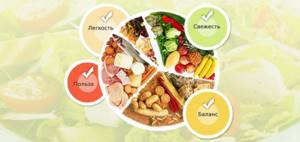
Since each cell receives the necessary substances from what a person eats, one should think about a healthy diet, in particular lunch. Why eat foods that don't benefit our cells? Okay, if only they were useless. Many of them cause irreparable harm!
What to eat for lunch
A balanced lunch, which harmoniously combines fats, proteins and carbohydrates, foods of plant and animal origin, will help maintain optimal blood glucose concentrations and excellent energy balance.
Nutritionists will tell you what lunch should consist of. They highlight several foods that are best for lunch.
- Soft-boiled eggs. The product is easily digestible and contains a large amount of useful substances. The most valuable of them are vitamins A, E, D, group B, as well as the minerals calcium, manganese and potassium. They support the functioning of the heart and blood vessels, improve the secretory function of the liver. Boiled eggs are allowed even with gastritis, but you should not eat more than 3 eggs a day due to their high cholesterol content.
- Oatmeal. This natural source of calcium and phosphorus is indispensable for children and the elderly, whose bone structure needs to be saturated with minerals. Thanks to the high fiber content, oat porridge quickly makes you feel full without overeating. Oatmeal is digested for 3 hours, releasing a large amount of energy and prolonging the interval between meals. Due to the low glycemic index, oatmeal is a good lunch option for diabetics.
- Buckwheat porridge. “The Queen of Cereals” is a real storehouse of microelements, vitamins, protein, healthy carbohydrates and fiber. In terms of energy value, buckwheat is similar to meat, so it can successfully replace it and interest vegetarians. Polyunsaturated fats in buckwheat porridge speed up metabolism and reduce the amount of cholesterol in the blood. Buckwheat gives you a feeling of satiety and at the same time rids the body of toxins and waste.
- Cottage cheese. The fermented milk product contains the healthy protein casein. It is easily digested, quickly absorbed and has high nutritional value. Cottage cheese can replace any protein of animal origin and will additionally supply the body with vital calcium and phosphorus. Homemade cottage cheese, which contains no preservatives, dyes or other synthetic additives, is considered the healthiest. To lose weight, you can include low-fat cottage cheese with fat content from 0.6 to 9% in your diet.
- Boiled chicken. Boiled skinless or steamed chicken meat is a dietary product rich in essential amino acids. Of particular value is easily digestible protein, which saturates well, but at the same time does not accumulate as excess weight. It is better to give preference to country chicken carcasses grown in natural conditions. When preparing “factory” boilers, it is better to drain the first broth - all harmful compounds are removed along with it.
- Kefir. The product is useful not so much for saturation as for normalizing metabolic processes. The acids contained in kefir help the dishes eaten at lunch be better absorbed, and a large number of beneficial bacteria support healthy intestinal microflora. The vitamin and mineral composition of the drink also deserves attention - vitamins A, C, group B, potassium, calcium, sodium, magnesium and fluorine.
- Jacket potatoes. A root vegetable cooked in its peel retains all the beneficial composition given by nature. A large amount of carbohydrates, an optimal amount of fiber and protein make the product ideal for lunch. At the same time, you need to take into account that you cannot season such a dish with oil or mayonnaise, otherwise all the benefits will instantly disappear.
- Fish. For your lunch meal, you can choose a type of fish that will satisfy your basic needs. For example, low-calorie tuna is better for weight loss, halibut will help improve your mood, and cod will help saturate your body with high-quality protein. A universal option is fish from the salmon family (trout, salmon, pink salmon); they will be especially useful for men and mental workers.
- Seasonal vegetables. Any salads made from fresh vegetables with the addition of herbs will only bring benefits. They are low in calories, but nutritious, rich in healthy fiber, vitamin and mineral compounds.
- Pasta. Only pasta products made from durum wheat are valuable. These types of pasta are considered very filling, but do not contribute to the accumulation of fat deposits.
- Whole wheat bread. Bread products made from wholemeal flour include substances contained in the grain shell - they are considered the most beneficial for health. Even a small piece of bread eaten during lunch keeps you feeling full for a long time and reduces cravings for sweets.
What foods are best to avoid?
Practice shows that most of the products that we are used to consuming daily not only do not provide health benefits, but are extremely harmful to it. First of all, you need to take into account that any cold food is contraindicated for lunch. Even the healthiest soup, served cold, slows down the digestion process and makes it difficult to absorb nutrients. Regular consumption of cold meals and snacks increases the risk of inflammatory diseases of the stomach and intestines and leads to excess weight.
Fast food and any snacks - chips, crackers, salted nuts - are strictly prohibited. This rule is especially true for children who find it difficult to avoid temptation during a long school day. In this case, it is better to provide a healthy snack for the schoolchild - dried fruits, unsalted nuts, bread, fruit. And for lunch it is better to order hot school meals.
What other products are undesirable:
- sausages, boiled and smoked sausages;
- salted and pickled vegetables in large quantities;
- sweet soda;
- instant soups;
- packaged instant pasta and mashed potatoes;
- fried flour products - pies, belyashi, peremech, chebureki;
- fatty sauces and mayonnaise.
At lunchtime you will have to give up sweets, especially to replace a balanced meal with them. Candy bars, chocolates, waffles and cakes quickly satisfy your hunger, but do not provide nutritional value. Nutritionists advise not to include desserts in your diet at all - an exception can be made only for natural cottage cheese, flavored with dried fruits or seasonal berries.
Video
Important! The energy norm for men is 2800-3000 kcal per day, for women – 2400-2600 kcal. Of these, lunch should account for 35-40%.
Three healthy lunch menu options: satisfying and healthy
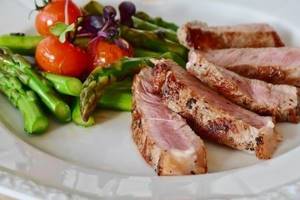
A healthy lunch menu doesn’t mean it’s long and expensive. On the contrary, the right meals are often simple to prepare and select ingredients.
Lunch menu No. 1
- Fresh salad of cucumbers and tomatoes, dressed with butter or sour cream.
- Vegetarian borscht.
- Boiled cod and potatoes.
- Green tea with lemon.
Lunch No. 2
- Sauerkraut.
- Buckwheat soup.
- Stuffed cabbage rolls.
- Sugar free coffee.
Lunch No. 3
- The vinaigrette.
- Tomato soup.
- Goulash with pasta.
- Fresh fruit compote.
It is recommended to create a menu for the week so that you don’t have to think about what to cook today.
Some main courses and broths for soups can be prepared for future use by freezing.
What to cook for lunch
Variety is the basic principle of healthy eating. To adhere to this rule, you need to think through different lunch options that will harmoniously combine proteins, carbohydrates and fats. Here are some simple, budget-friendly, but healthy recipes that you can use when creating a home menu.
Buckwheat porridge in merchant style
List of ingredients:
- faceted glass of buckwheat (about 200 g);
- chicken fillet (300-400 g);
- a set of vegetables - carrots, onions, sweet peppers;
- butter;
- pepper and salt to taste.
How to cook:
- Cut the chicken into cubes or small pieces, fry in butter until white.
- While the meat is cooking, wash the vegetables, cut them as desired, you can grate the carrots on a coarse grater.
- Place the vegetables in the frying pan with the meat and sauté for 5-7 minutes.
- Place everything in a thick-bottomed saucepan or cauldron.
- Sort through the buckwheat, removing the black grains, and rinse several times under running water.
- Add the cereal to the cauldron and add two glasses of clean water.
- As soon as the mixture boils, cover the container with a lid and leave to simmer over low heat.
- The dish is considered ready as soon as the water evaporates.
Greens - dill, cilantro or parsley - will help make buckwheat even more useful in a merchant's style. But you should sprinkle the finished dish immediately before the meal.
Chicken soup with egg
Product set:
- any part of chicken for broth;
- 1 onion and carrot each;
- 3 medium potatoes;
- 1 egg;
- vegetable oil – 2-3 tablespoons;
- seasonings and herbs to taste.
Step-by-step preparation:
- Boil the chicken broth, remembering to skim off the foam. You can drain the first broth and boil the chicken in the second water for another 10 minutes.
- Cut the peeled potatoes into medium cubes and place in a saucepan with broth.
- Prepare a fry from grated carrots and finely chopped onions. Sauté in vegetable oil for about 10 minutes.
- Add roast, salt and spices to the soup and simmer for 10 minutes.
- Lightly beat the raw egg in a separate container and pour into the pan in a thin stream. The egg should be stirred well so that it separates into thin fibers in the water.
- After 5 minutes, the soup can be removed from the heat.
Greens should be poured into a plate immediately before eating. The dish is prepared very quickly, but it turns out nutritious and healthy.
Homemade beetroot grower
Grocery list:
- 4 small beets and potatoes each;
- 1 onion;
- 1 carrot;
- 2 garlic cloves;
- half a lemon;
- bay leaf, salt, sunflower oil.
How to cook:
- Peel all the beets and cook over low heat for an hour. Do not drain the broth.
- Cool the boiled beets and cut into strips.
- Place chopped potatoes and frying made from onions, garlic and carrots into boiling beet broth.
- After 5 minutes, add the beets and cook for about 10 minutes.
- Salt the beetroot soup, season with bay leaf, and add lemon juice at the end.
Removed from the heat, the beetroot must sit under a closed lid for at least 30 minutes. Serve the dish with your favorite herbs; you can season it with dietary mayonnaise or sour cream.
Oatmeal cheesecakes
What you need for the recipe:
- 200 g cottage cheese of any fat content;
- 1 chicken egg;
- 4 large spoons of oatmeal + a couple of spoons for breading;
- salt or sugar to taste.
Step-by-step preparation:
- Mash the cottage cheese with salt or sugar in a separate bowl until you obtain small grains.
- Add the egg and cereal and mix until smooth.
- Add a little more breading flakes to a flat plate.
- Use a spoon or your hands to form cheesecakes, rolling them in flakes on a flat plate.
- Fry the cheesecakes in vegetable oil on both sides until a pleasant golden hue.
This dish should be eaten hot with sour cream, jam, or any low-fat sauce.
Vegetable omelette in the oven
Ingredients:
- 3 eggs;
- a set of any vegetables - green peas, canned corn, broccoli, green beans, tomatoes, bell peppers, cauliflower, zucchini, etc.;
- 150 ml whole milk;
- 100 g hard grated cheese;
- salt, pepper, vegetable oil.
Description of preparation:
- Prepare the vegetables, chop and fry in a pan for 5 minutes. If the ingredients are still hard, you can simmer them covered until half cooked. For one omelet it is better to take no more than 3-4 types of vegetables.
- Grease a baking dish with a small amount of oil and add vegetables.
- Beat eggs with salt, milk and pepper, pour over vegetable mixture.
- Preheat the oven to 190°C, place the omelette pan in it and bake for 15-20 minutes.
- 3 minutes before cooking, sprinkle the dish with cheese.
Healthy dinner
Example of an evening menu:
- cottage cheese casserole, natural yogurt;
- vegetable smoothies;
- seafood, fish;
- steam cutlets;
- protein omelet with green beans, spinach, broccoli, etc.;
- chickpeas and lentils stewed with tomatoes and sweet peppers.
Many people believe that it is better to eat porridge in the evening to satisfy their appetite throughout the night. However, this is not a pp, because This dish contains complex carbohydrates that take a long time to break down.
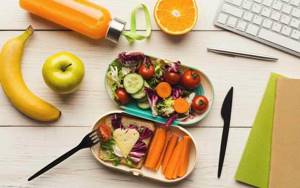
A healthy diet is essentially designed to provide the body with all the necessary nutrients and microelements.
Reviews
Anna, 29 years old : “After giving birth, I set myself the goal of losing 10 kg. At first I followed the Japanese diet, but I realized that it was not suitable for me, so I decided to switch to familiar but healthy foods. I never skip breakfast and lunch; I plan the menu in advance and take food in containers to work. I especially like cottage cheese with berries, vegetable salads and dishes with chicken breast. Once a week I arrange a small “food” holiday for myself - I eat my favorite candy bar or chocolate bar, I can allow myself some chips. I’ve already managed to lose 4 kg, and I feel amazingly light and don’t feel hungry at all.”
Alexey, 33 years old : “I work in a women’s team, where local employees cannot imagine their life without sweets and baked goods. No lunch is complete without cookies, pies, sweets and other delicacies. They treat me too, so it’s difficult to resist, much less maintain a “correct” lunch. After being hospitalized with an exacerbation of gastritis, I firmly decided to eat separately at work and follow my own diet. At first it was inconvenient to take with me all these soups in thermoses prepared by my wife, salads and porridges. But in just a couple of weeks I adapted so much and fell in love with healthy eating that now I remember my past habits with horror. It especially stimulates good health, which I can’t complain about since I started eating healthy.”
Conclusion
Vitaminized, balanced, nutritious and timely - this should be the right lunch for a child and an adult. But the lack of a full daily meal is a dangerous habit that negatively affects overall health, well-being and attractiveness of shape.
Prohibited foods and dishes
It is a mistake to think that diet relaxations are allowed during the day. With proper nutrition and weight loss, the list of prohibited foods applies to all meals, regardless of the time of day.
Harmful products:
- fried, smoked food;
- red meat: beef, lamb;
- whole dairy products: cream, full-fat cheeses
- refined sugar;
- baked goods, confectionery;
- packaged snacks: chips, crackers;
- margarine;
- hydrogenated vegetable oil;
- carbonated drinks.
When purchasing products labeled “diet”, carefully read the ingredients. Unscrupulous manufacturers add artificial sweeteners for taste.
